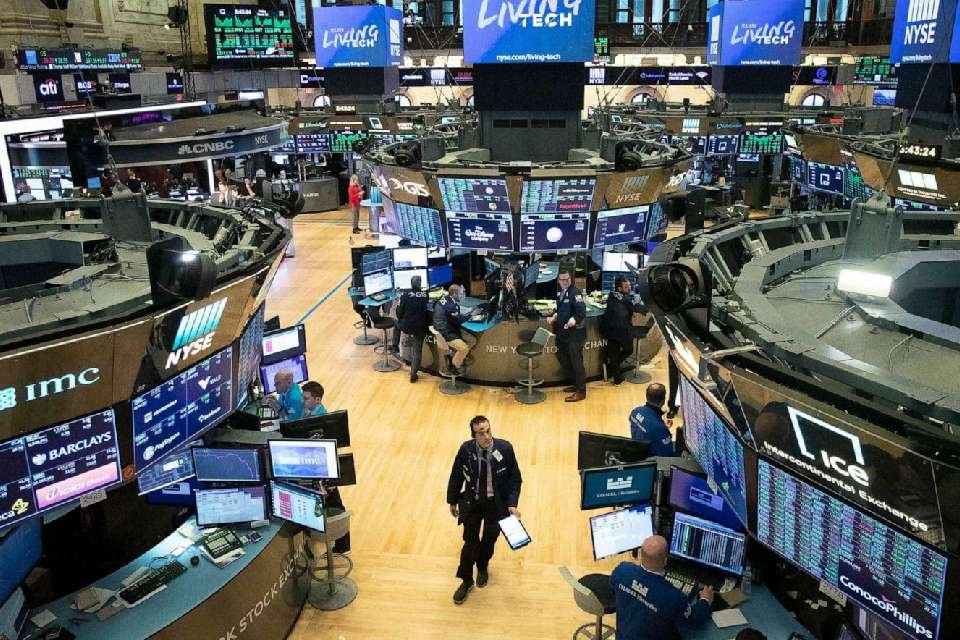
On Friday, the U.S. stock market suffered its second consecutive weekly loss, causing stocks to fall. The S&P 500 was down 1.1% at the close, the Dow was down 0.9%, and the Nasdaq was down 1%.
S&P Global’s preliminary readings on economic activity in the United States this month, which showed a further deterioration in activity to begin December, were the catalyst for stocks’ leg lower on Friday.
In December, S&P Global’s manufacturing index reached a 31-month low, while the services PMI fell to a four-month low.
Chris Williamson, chief business economist at S&P Global Market Intelligence, stated, “Business conditions are worsening as 2022 draws to a close, with a steep fall in the PMI indicative of GDP contracting in the fourth quarter at an annualized rate of around 1.5%.” In the meantime, job growth has slowed to a crawl as businesses in manufacturing and service take a much more cautious approach to hiring due to the decline in customer demand.
Concern over the health of the U.S. consumer, which has been the driving force behind a better-than-expected economy this year, was sparked on Thursday by the unexpectedly weak November retail sales report.
Financial backers likewise had an eye on raw petroleum Friday, with WTI fates down over 3% to exchange close $74.30 a barrel. Oil reached a new 2022 low early this week.
During a historically bullish period, the market’s losses on Friday sealed another week of losses. The S&P 500 experienced its worst weekly loss since late September last week.
The Nasdaq’s deep sell-off on Thursday, which saw it fall more than 3%, was followed by trading on Friday. The Federal Reserve’s interest-rate increase on Wednesday was followed by matching moves from the Bank of England and the European Central Bank on Thursday morning.
At the Federal Reserve Building in Washington, United States, on December 14, 2022, Federal Reserve Board Chairman Jerome Powell walks out of a news conference following the announcement that the Federal Reserve raised interest rates by half a percentage point.
There was little news on the earnings calendar, with Darden Restaurants (DRI) and Winnebago Industries (WGO) both increasing following their most recent reports.
Bitcoin (BTC-USD) and other major cryptocurrencies were under selling pressure in the cryptocurrency markets on Friday, with bitcoin falling below $17,000. Bitcoin had surpassed $18,000 earlier this week for the first time since the collapse of FTX at the beginning of November.
Early on Friday, news that accounting firm Mazars had stopped working with Binance and all other crypto firms weighed on the market.
As concerns grew that the Federal Reserve and other central banks are willing to initiate a recession in order to contain inflation, Wall Street suffered additional losses on Friday.
The S&P 500 fell 1.1%, its third consecutive drop. The Nasdaq composite lost 1%, while the Dow Jones Industrial Average lost 0.8 percent. The major indexes suffered their second weekly decline in a row.
There was a large pullback. More than 80% of the S&P 500’s benchmark stocks went down. Innovation and medical services stocks were among the greatest loads available. Pfizer lost 4.1% and Microsoft lost 1.7%.
This week, the Federal Reserve tried to put an end to some investors’ hopes that it would cut interest rates next year by raising its forecast for how high it will eventually go. Many investors perceived the European central bank as even more aggressive.
SoFi’s head of investment strategy Liz Young said, “Inflation continues to be the monster in the room.”
Although it has decreased from its highest levels in decades, inflation is still painfully high. As a result, the Federal Reserve has continued its aggressive price war by raising interest rates to halt economic expansion. The strategy runs the growing risk of putting too much pressure on the brakes and sending an economy that is already slowing down into a recession.
Young stated, “Whether it’s a moderate, deep, or mild recession is still unknown.”
The possibility of a recession was highlighted in S&P Global’s mixed report on Friday. It demonstrated that, as companies are squeezed by inflation, business activity slowed more than anticipated this month. It also noted that inflation pressures have been decreasing and that this was the sharpest drop since May 2020.
Chris Williamson, chief business economist at S&P Global Market Intelligence, stated, “In short, the survey data suggest that Fed rate hikes are having the desired effect on inflation, but that the economic cost is building and recession risks are consequently increasing.”
To 3,852.36, the S&P 500 lost 43.39 points. It’s presently down around 19% this year. The Dow dropped 281.76 points to 32,920.46 at the end of the day. To 10,705.41, the Nasdaq lost 105.11 points.
The market as a whole experienced more severe losses than small company stocks. The Russell 2000 fell 11.19 focuses, or 0.6%, to 1,763.42.
The yields on bonds varied. The 10-year Treasury yield, which has an impact on mortgage rates, increased to 3.49 percent late on Thursday from 3.45 percent. The two-year Treasury yield, which closely tracks Fed expectations, decreased to 4.21 percent late on Thursday from 4.24 percent.
The Federal Reserve raised its short-term interest rate by half a percentage point on Wednesday, marking the seventh time in a row this year. Wall Street had expected the Federal Reserve to indicate that rate increases would ease into 2023, but the Fed instead indicated the opposite.
The federal funds rate has reached its highest level in 15 years, ranging from 4.25 percent to 4.5 percent. By the end of 2023, Fed policymakers anticipate that the central bank’s rate will range from 5% to 5.25 percent. Their figure doesn’t require a rate cut before 2024.
After releasing positive financial results and forecasts, a number of businesses overcame the overall losses on Friday. After surpassing Wall Street’s expectations for fiscal fourth-quarter earnings, software company Adobe gained 3%. After providing investors with a strong earnings forecast, United States Steel saw a gain of 5.8%.
The Dow fell nearly 300 points on Friday. Why stocks keep tumbling?
Wall Street’s positive vibes are rapidly fading: As investors confront a weakening economy, the US slid further on Friday.
The Dow finished the day down 282 focuses, or 0.9%. The Nasdaq Composite and the S&P 500 both declined by 1%.
The sell-off has been widespread, but the real estate and consumer discretionary industries have been hardest hit, with declines of more than 3% and 1.8 percent, respectively.
Is it the Fed’s fault? This week demonstrates that sentiment on Wall Street can shift at any time: The Dow has tumbled around 1,050 focuses just since the Central bank’s dismal approach update at 2 p.m. ET Wednesday.
A gauge of market sentiment, CNN Business’s Fear and Greed Index, finally fell into “Fear” on Friday. For several weeks, the market has been acting “greedy.”
This month, inflation that was lower than expected and a number of stronger-than-expected reports on the economy as a whole and the job market had pushed stocks higher. Investors had high hopes that the Federal Reserve would be able to slow down its historic rate hike pace and that inflation would return to normal by the end of the year without sending the economy into a recession.
That excitement persisted until Fed Chair Jerome Powell brought bad news to Wall Street’s party on Wednesday: Business analysts at the Fed accept US total national output, the broadest proportion of America’s economy, will scarcely develop one year from now.
Additionally, they anticipate that the unemployment rate in the United States will rise to 4.6 percent by the end of 2023, putting an additional 1.6 million Americans out of work.
Worse-than-expected retail sales data on Thursday sent stocks plunging, further fueling concerns stemming from those Fed forecasts. Thursday marked the Dow’s worst day in three months, with a loss of 765 points, or 2.3%. The Nasdaq plunged 3.2% and the S&P 500 lost 2.5%, respectively, on their worst days in a month.
Moody’s Analytics economists now anticipate that the United States economy will expand at an annualized rate of just 1.9 percent in the fourth quarter, down from its previous estimate of 2.7 percent. Moody’s analysts were alarmed by weak manufacturing and retail reports, which also caused them to lower their GDP forecast for 2023 to just 0.9%, which is significantly less than the 1.9% estimate for 2022.
In an analysis, Moody’s economist Matt Colyar wrote, “This leaves little room for anything to go wrong.”
Not aiding stocks: December is here. Numerous brokers are holiday, volume is low and small moves can get exacerbated.
The market may be in a lose-lose situation, as my colleague Matt Egan points out. Investors have reacted negatively to positive economic news because the Federal Reserve is attempting to calm the economy as part of its campaign to combat inflation. However, bad economic news also makes a recession more likely, which is bad for investors and everyone else.
With gains of 3% and 2.8%, Adobe (ADBE) and Meta, the parent company of Facebook, lead the market today. Adobe (ADBE) shares took off after the organization announced surprisingly good quarterly profit and direction. After JPMorgan downgraded the company’s shares from overweight to neutral, Meta saw a tick. The stock is still down nearly 65 percent for the year.


